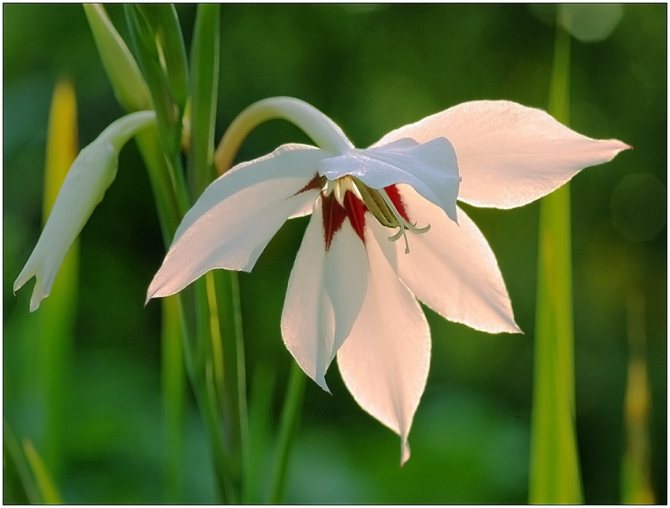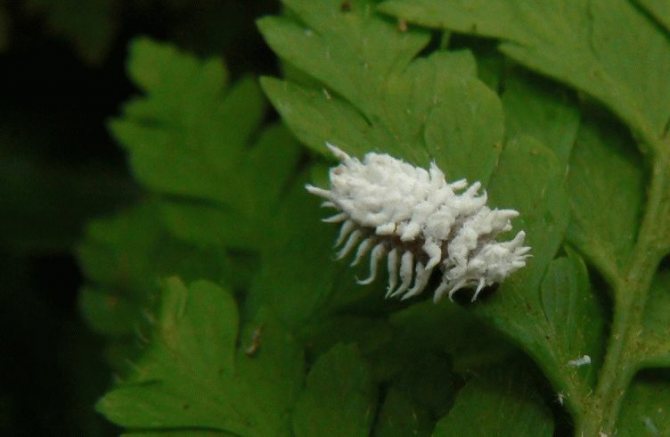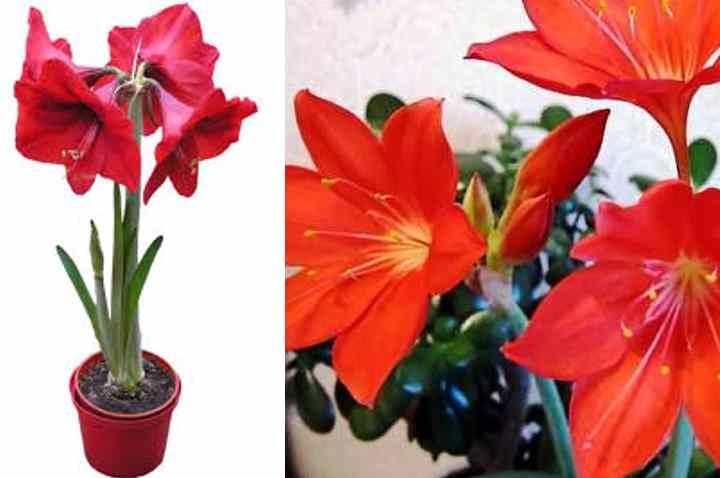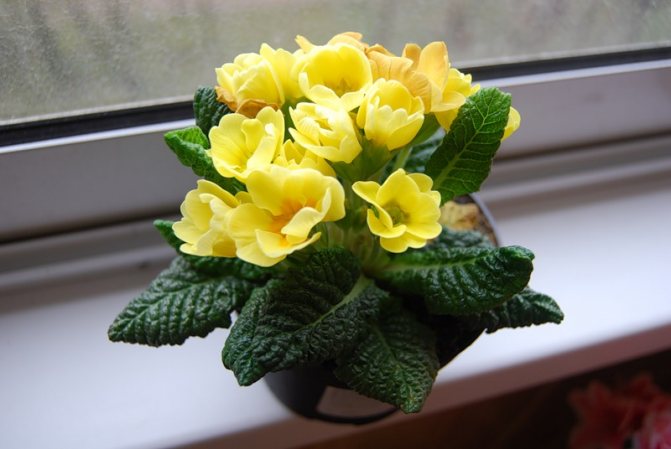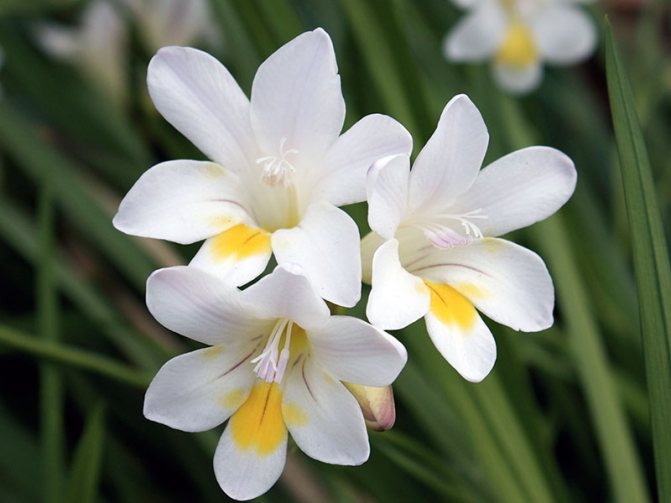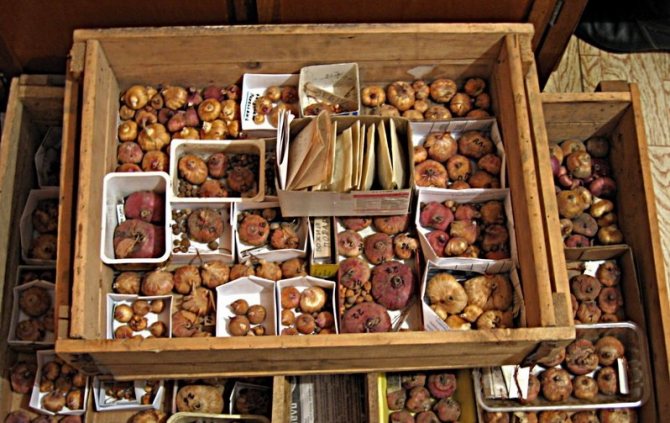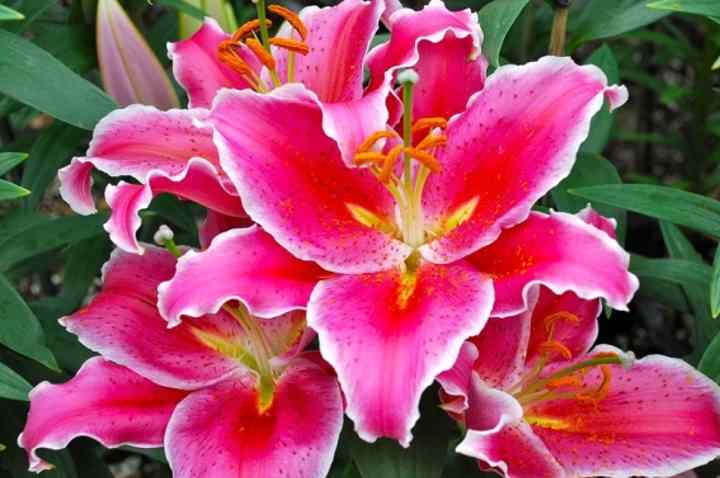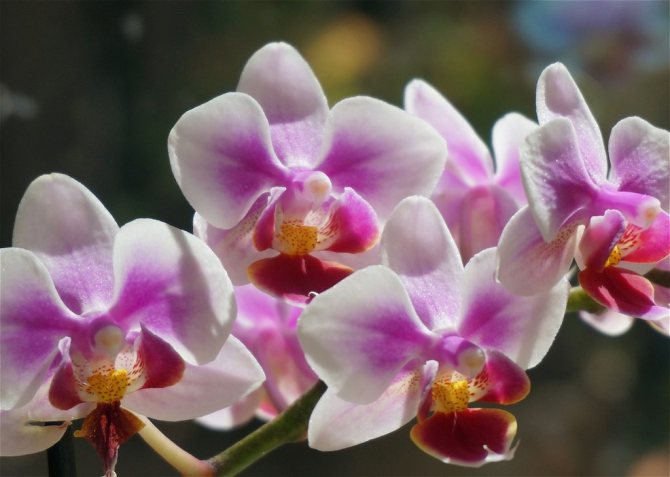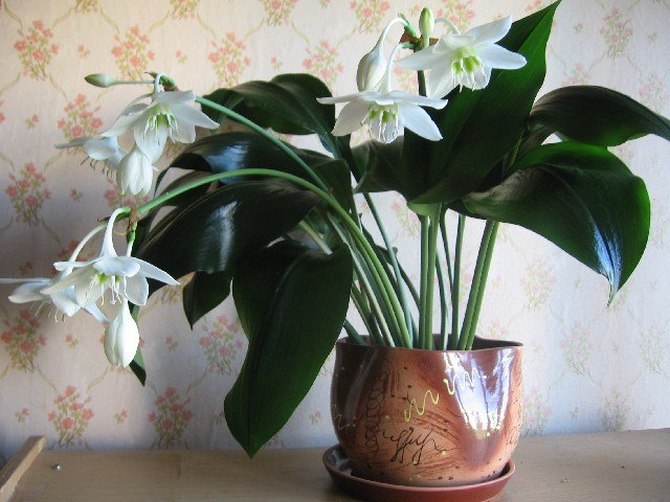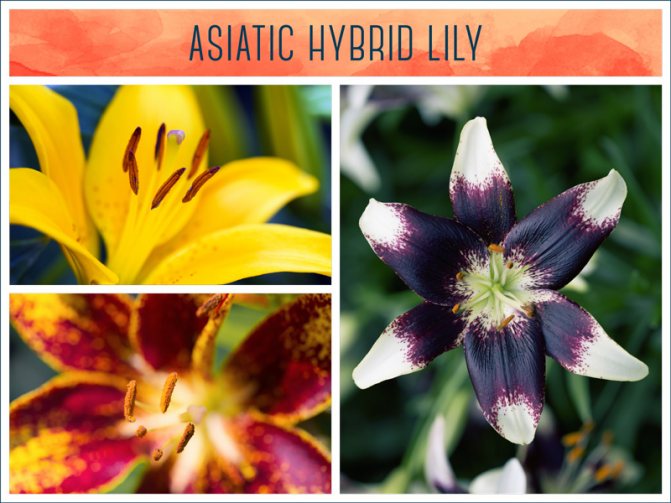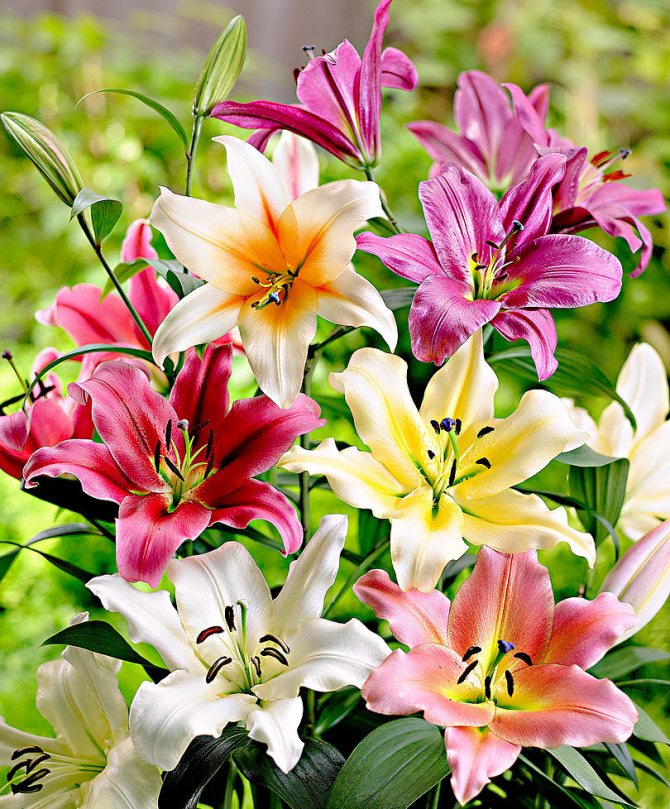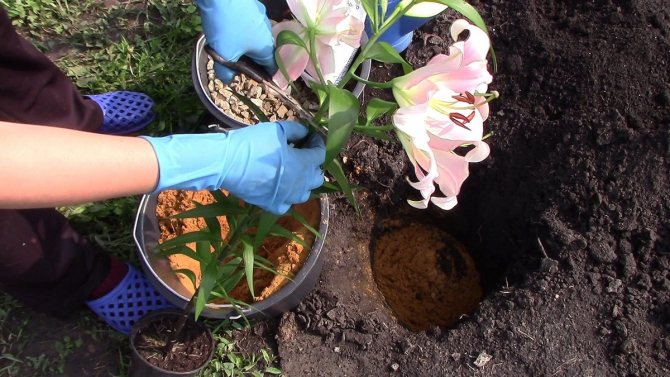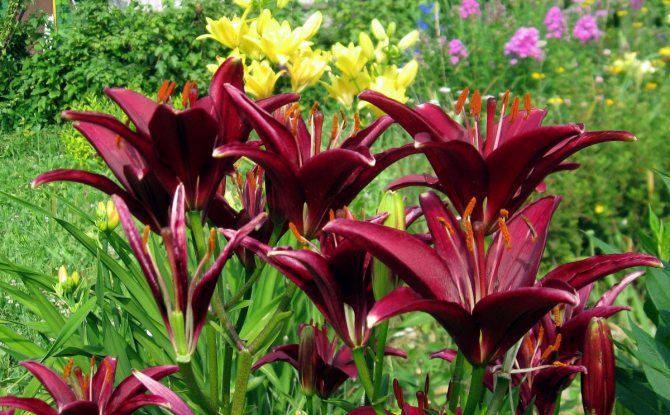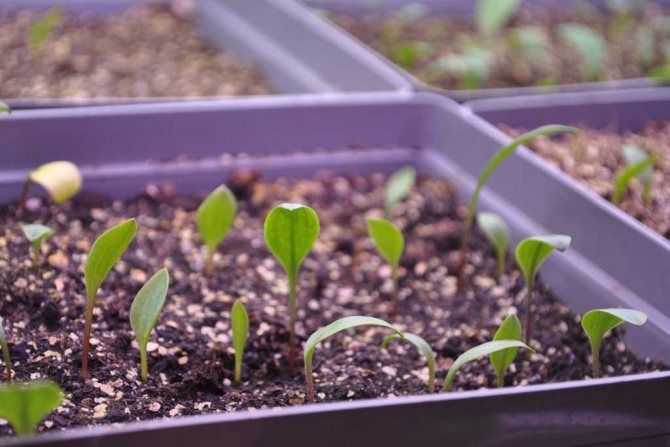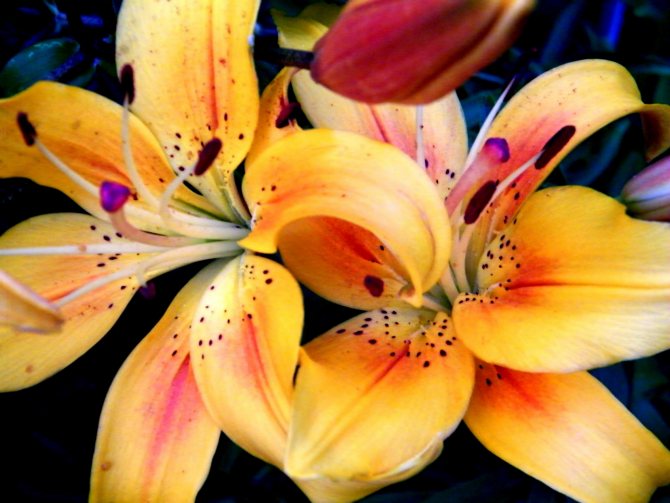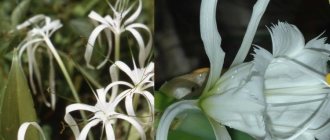Lily is truly considered the royal flower. Even in Ancient Greece, this flower was exalted, endowed with the symbolism of purity and tenderness. Further in the article, we will focus on the room lily, which is not inferior in its beauty to the garden flower of the same name. How to care for a room lily at home?
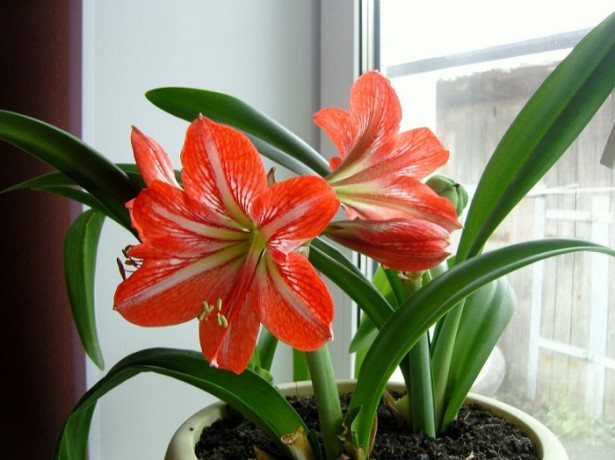
Home care for eucharis
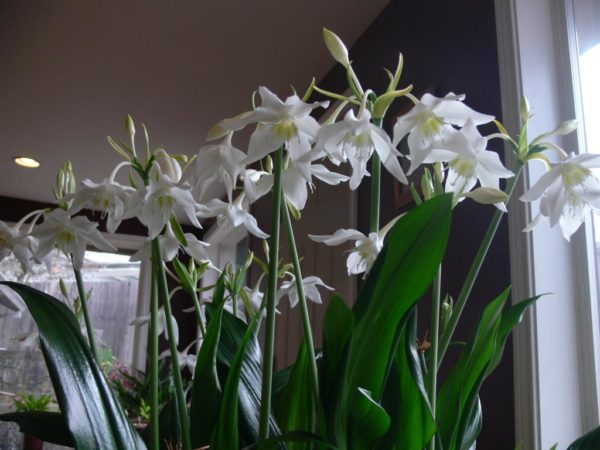

The Amazon lily should be protected from direct sunlight.
Correct lighting
The Amazonian lily prefers uniform, diffused lighting. The plant is also able to maintain a bright color in partial shade. To grow eucharis, window sills should be prepared on the west or south side of the building. Indoor lily is difficult to tolerate exposure to sunlight.
Temperature regime
Eucharis needs to create comfortable warm conditions. In the summer, the optimum air temperature for a flower is from + 23 to + 30 degrees.
Prepare a cool room in winter. The thermometer mark should be at the level of + 15— + 18 degrees.
The plant does not tolerate drafts and gusts of wind. Open windows in winter can harm the Amazon lily. Just a few hours of cool air will cause the foliage to fall off.
How to water a plant
The Amazonian lily prefers an even moisture content of the substrate during the active growing season and flowering. In swampy soil, the root system begins to rot. In a few days, the plant will die.
After the withering of the inflorescences, the Amazonian lily enters a dormant period. During the entire rest period (about forty-five days), you can water the plant no more than two times.
Environment humidity
Indoor lily responds well to high humidity in the room. A plant without inflorescences can be regularly sprayed with standing water at room temperature.
It is important to monitor the condition of the leaves. It is not advisable to allow stagnation of water at the base of the vegetative organs.
At the stage of budding and abundant flowering, spraying should be stopped. Inflorescences can die from water droplets.
Eucharia should be wiped periodically. Dust often accumulates on the leaves. It is recommended to use a dry sponge first. After removing the dirt, you can wipe the areas with a damp cloth. Failure to follow the recommendations can clog the stomata. The leaves of the culture will not be able to continue gas exchange with the environment.
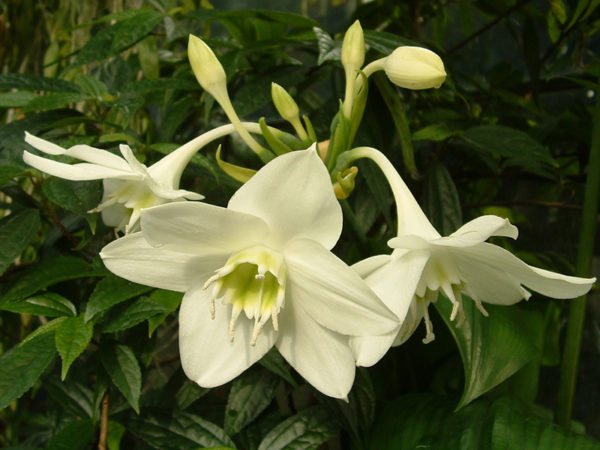

During the flowering period, it is not recommended to spray water on the crop.
How to transplant
Indoor lily is capable of actively developing in one container for about four years. It is recommended to replant the grown plant after the first flowering as the bulbs grow. Young eucharis should be replanted annually. If colonies of modified roots do not fit in the pot, the container must be changed.
To grow eucharis, you need to use large, wide pots. At the bottom of the container, it is advisable to lay out a thick layer of drainage.
It is necessary to carry out the procedure by the transshipment method at the end of March. Eucharis reacts hard to moisture loss and damage to the root system. For a transplant you need:
- Gently loosen the substrate with a small garden trowel.
- Spread out massive roots.
- To avoid damaging tangled areas, you can rinse the root system under running water.
- Separated bulbs should be planted at a depth of about three centimeters.
- If a purchased bulb is transplanted without leaves, you need to place the eucharis in the container with the crown up. The top should remain on the surface of the earth.
- It is necessary to thoroughly compact the substrate.
- The plant should be constantly examined for three weeks. Successful rooting can be seen thanks to the exposed area.
- Watering a room lily should be rare. You can determine the need for wetting the substrate by touch.
- If the planting material has leaves, it is necessary to regularly spray the plant.
- In conditions of high humidity, new leaves will appear on the bulb after 45 days.
Dormant period
The Amazonian lily differs from other representatives of the amaryllis in the absence of a pronounced dormant period. The plant does not shed its leaves in winter. The loss of vegetative organs is evidence of the defeat of the culture. Eucharis may die.
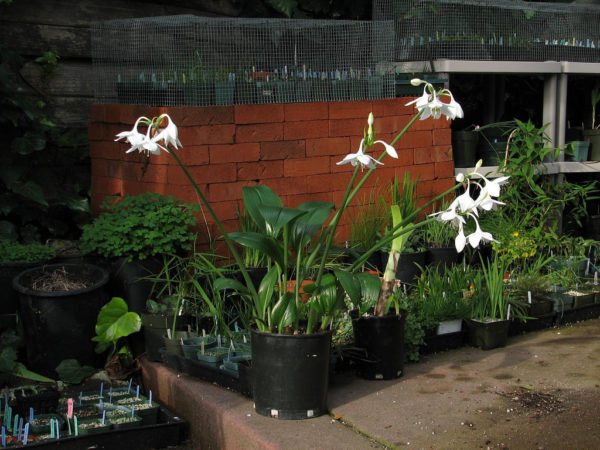

The plant does not have a pronounced rest period.
After flowering, it is advisable to reduce watering for sixty days. The plant will be able to recuperate.
The need for pruning
Eucharis does not need constant pruning. It is enough to cleanse the culture of fading peduncles as it wilts.
For more information on planting and transplanting a flower, see the video:
How and when to prune lilies after flowering
One of the important things to do with lilies after they have faded is pruning. If the stems with faded inflorescences are cut off early, immediately after flowering, the development and growth of the bulb stops due to the cessation of photosynthesis in the ground part. A weakened plant can hardly tolerate winter cold and by the new season one should not expect high decorative effect from it.
Important! It is recommended to remove wilted peduncles from the bush, on which seed pods have begun to ripen.


Lily bloom
You need to cut the stem with sharp tools: a knife, garden shears, which must be disinfected. So that moisture does not accumulate on the cut and conditions are not created for the development of pathogens, the cut is made obliquely.
Flower beds with withered lilies look unattractive. To increase their decorative effect, the drying inflorescences are closed by sowing rapidly developing annual flowers in front of the lily bushes: petunias, marigolds.
Amazon lily in an open area
In tropical countries, eucharis is grown as a horticultural crop. The plant is able to keep fresh for a long time. Therefore, the lily is often cultivated for cutting.
In the northern regions, the flower is grown in a greenhouse and winter gardens. The indoor lily flower is especially popular.
Florists often experiment with eucharis. The container plant is able to withstand the outdoor conditions of the temperate continental climate during the warmer months. It is advisable to prepare a sheltered place in the gazebo or on the balcony. The flower will be able to maintain its decorative effect, provided that there are no sharp temperature fluctuations and a sudden cold snap at night.
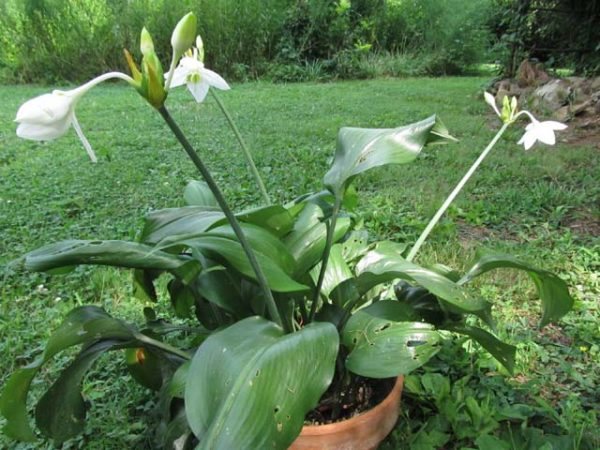

Eucharis can only be kept outdoors in a closed container.
What you need to know about storing and wintering lilies
In the case of spring planting of lilies, care must be taken to store them throughout the winter months. For this, cool, dry and well-ventilated rooms (basement, cellar) or the bottom shelf of the refrigerator are suitable.
In order for the dug out bulbs to successfully endure the winter, they are placed in shallow wooden boxes (plastic ones are allowed), sprinkled with a mixture of sawdust, peat and coarse sand. The option with boxes is also suitable - for this, the planting material is shifted with layers of sphagnum moss or burlap.
If the bulbs are to be stored in the refrigerator, they must be placed in bags of peat or sawdust. You can also use a damp natural cloth in which the lilies are carefully wrapped.
Babies, separated from the mother's bulb, survive best overwintering in the ground, as they often dry out without soil. To do this, they are planted in boxes or pots filled with loose sandy soil and stored at a temperature of + 4- + 6 degrees.
For areas with mild and warm winters, lilies overwinter on the balcony. The dug out bulbs are planted in pots and stored until spring, transferred to open ground at stable temperatures above zero.
Indoor lily - the secrets of growing
Soil mixture
To plant eucharis, you need to prepare a substrate of humus, leafy earth, ventilated softened peat, as well as clean river sand. It is also recommended to use "Nitrofoska" and wood ash.
Top dressing
The increase in the green mass of eucharis depends on the quality and timeliness of feeding. How to apply fertilizer correctly? For the Amazonian lily, you should prepare a mineral mixture for flowering houseplants or "Nitrophoska". Pour half a teaspoon of the product with one liter of water. It is recommended to use the solution no more than three times a month.
Before applying the drug, it is imperative to moisten the soil. Fertilizer in combination with a dry substrate can burn stems and leaves.
How to choose a flower pot
Large-flowered Eucharis should be planted in shallow, wide containers. The container must be stable. Several large holes must be made in the bottom to drain excess water.
Propagation by cuttings
Another easy way to propagate lilies after flowering is by cuttings. You can use a leaf with a stem piece or just a leaf, part of a stem with a dormant bud. To obtain cuttings, the stem is divided into parts with 5-7 leaves, the lower ones are removed, leaving 2-3 upper ones on the cutting. A leaf for grafting is taken at the top of the stem.
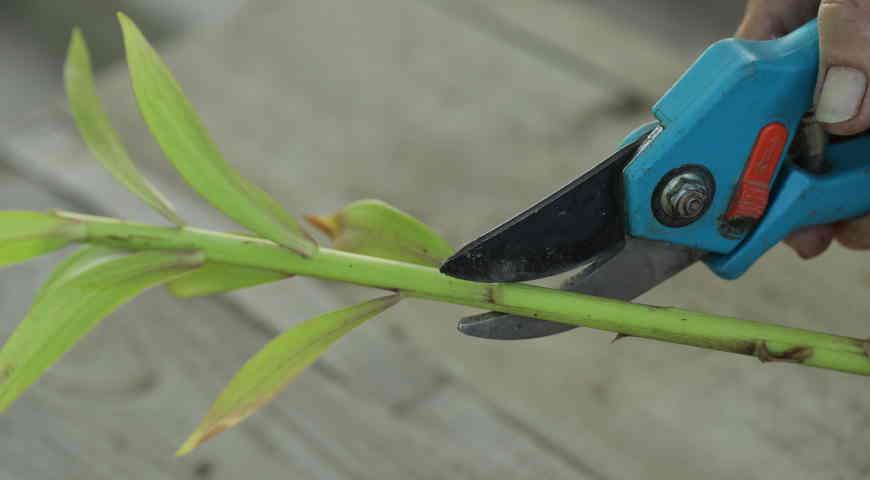

Propagation by cuttings
The prepared parts of the plant are treated with a solution of a growth stimulant, keeping in it for up to 12 hours. Then they are planted in prepared containers filled with a fertile substrate.
Note! All summer is suitable for propagation by cuttings, especially July, when the plant is in the budding or flowering period. The cuttings obtained at this time have a greater vigor of growth, are distinguished by better survival rates.
Leaves and cuttings to the middle of their length are deepened, slightly tilted, into the fertile black earth and covered with cellophane or covered with a glass jar. Water regularly, ventilate every day, lifting a film or jar. Remove the moisture droplets from the covering material before returning it to its place.
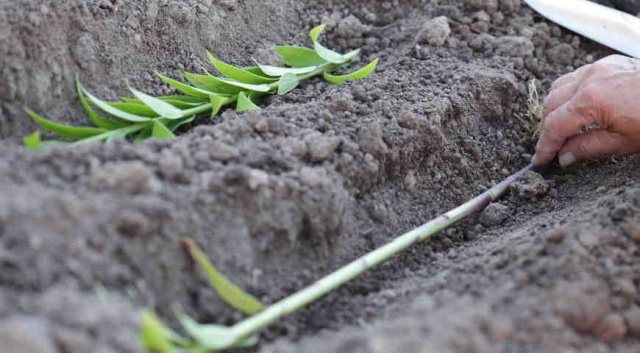

Rooting
After 1-2 months, the parts of the plant buried in the ground take root, and young leaves begin to grow from the formed bulbs. The cuttings that have gone into growth are planted in separate containers and grown until spring. In the spring, seedlings are planted in open ground.
Lilies obtained by stem cuttings can bloom already in the first or second year of planting.
Spring cuttings
You can propagate a flower by stem cuttings in the spring with planting in open ground. The plant is dug up in the spring, the stems are separated and planted in a greenhouse.
For 1.5-2 months, small bulbs grow on the end of the stem buried in the ground.
Additional Information. To increase the number of bulbs on the cuttings, several shallow longitudinal cuts are made on the stem before diving into the ground. This activates the growth of bulbs, their number can be about 40 pieces.
The rules for caring for lilies are simple and straightforward. Their performance largely depends on how the daylily near the house or an indoor flower will look. And every grower is interested in healthy, beautiful plants.
What affects large-flowered eucharis
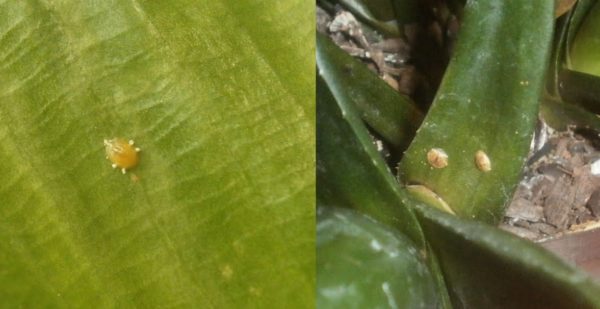

Parasites can settle on eucharis.
The Amazon lily differs from other members of the family in its unpretentiousness. The plant forms buds easily every year. With proper care, you can get an abundantly blooming crop.
To create a spectacular bush, you can plant several bulbs in a large container. Regular feeding stimulates the formation of numerous leaves. Eucharis is not recommended to be planted in a group with other plants. Room lilies need to create sufficient space.
Despite the significant advantages, complete non-observance of the rules of care can cause damage to the plant by diseases and the appearance of pests.
The main danger among insects for eucharis is scale insects. The appearance of brown plaques on the leaf blades and stems indicates the defeat of the flower.
Parasites in a matter of days of "inactivity" can suck the juices from the tissues of the lily. How to save eucharis? The plant should be inspected regularly. At the first signs of loss of leaf gloss, revealing drying and fallen areas, pests should be collected. You can also catch insects using special traps.
The cleaned plant must be treated with soapy water. It is advisable to wipe the leaves with a damp sponge dipped in soapy water. All areas should be sprayed with Actellika solution. You will need a 0.15% drug. For one procedure, it is recommended to use two milliliters of the product and one liter of settled water.
Dry air, combined with high ambient temperatures, promotes thrips to settle on lilies. Insect colonies primarily settle in the lower areas of the leaves. The characteristic light markings can be seen on the top of the plate.
Insecticides will be required to kill pests. Decis, Fitoverm, Intavir and Aktellik have an effective effect on parasites.
Decorative component
When the plant reaches a certain size and the florist considers that the time has come for flowering, it is enough to apply a growth stimulator. It is introduced into the soil or sprayed with a room lily in a diluted form, and buds begin to appear on the plant. In the photo attached to the care instructions, you can often see that under large and abundant inflorescences, it is imperative to install a support, otherwise there is a risk that the peduncles will break.
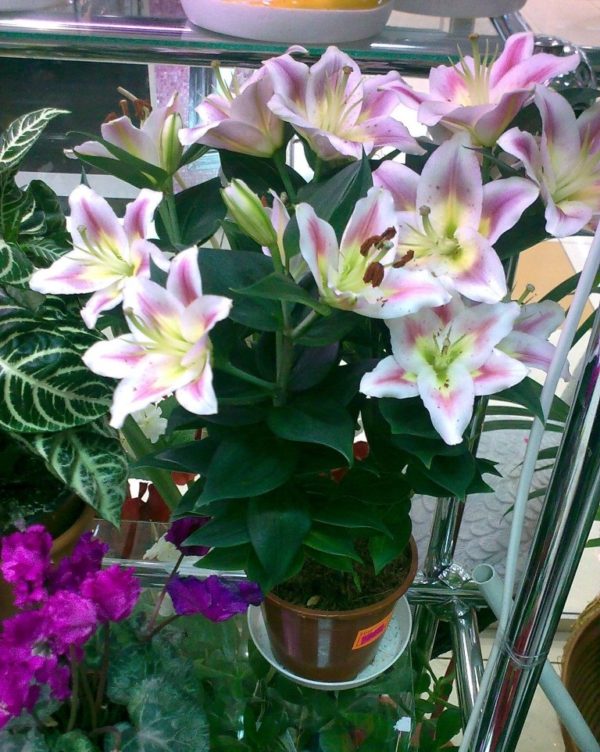

Advice!
For long-term flowering, it is recommended to make sure to add nutrient mixtures and remember that the flower loves moist soil, but not completely flooded with water. This means that at home it needs to be watered constantly, but not abundantly, ensuring that the soil is always moist. Do not use hard water or tap liquid for irrigation. If possible, use thawed or rainwater, if not - settled.
Some amateurs use chilled boiled for this purpose. During hot seasons, you can spray some additional moisture directly into the air if it is dry.
How to propagate a lily at home
A large accumulation of daughter bulbs on the mother plant creates a lush eucharisa shape. The cramped space initially reduces the development of the indoor lily. Insufficient nutrients and root tangles can kill all plants in one container. Therefore, as the lily grows, the separated bulbs should be transplanted into new containers. Adequate pot volume stimulates flowering of the crop. Annual separation of small lilies is allowed.
It is advisable to perform the disconnection during transplantation. Only formed babies are suitable for the spread of eucharis. It is important to carry out the procedure carefully. Brittle roots can be damaged easily.
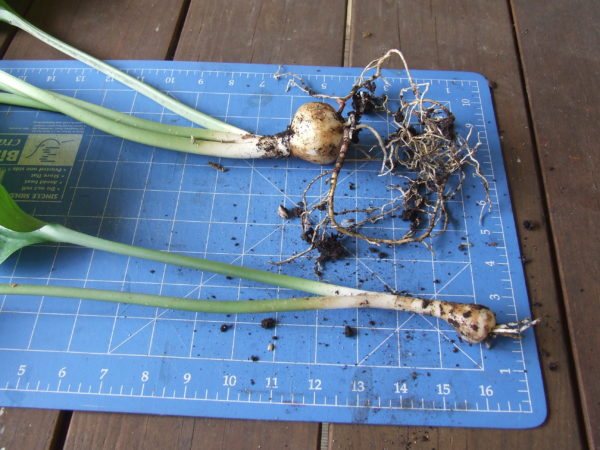

Reproduction of eucharis bulbs.
Separated bulbs should be planted in pre-prepared wide containers with several holes. At the bottom of the container, you need to line a drainage layer of crockery shards, expanded clay or pebbles. On top, you need two handfuls of clean, medium-grit sand. You can plant about five children in one pot. Planting depth should not exceed five centimeters.
Why plant Eucharis in a group? Several representatives in a cramped container guarantee a lush bloom. Single plantings of lilies will not be able to form inflorescences until the necessary growth of the bulbs.
For children, you will need to mix a special substrate. You should prepare:
- compost;
- leafy ground;
- loam;
- coarse sand.
The modified roots also respond well to heather, deciduous and sod soil. Heather substrate can be replaced with peat.
How to properly dig up bulbs
Lilies do not require an annual transplant and feel great in one place for 4-5 years. However, sometimes the bulbs still need to be dug up due to the following reasons:
- The desire of the grower to propagate the culture;
- Low frost resistance and other features of a particular variety;
- The development of diseases and the oppressed appearance of the plant;
- Decrease in the quality of flowering - shrinking flowers, their underdevelopment.
It is important to dig up the bulbs no earlier than 4-6 weeks after flowering - in this case, the planting material will not die. After the lilies have bloomed, the stem must completely fade in order for the lily to enter a dormant state (see photo).
Further, the lilies are dug out in compliance with several stages:
- Dried plant stems are cut, the bulbs are removed from the ground and cleaned of the ground;
- The planting material is carefully examined, all sick, dried, rotten and suspicious scales are removed;
- Babies are carefully separated from the mother's bulb;
- For disinfection, lilies are soaked in a concentrated solution of potassium permanganate, then dried in a well-ventilated and shaded place.
Why does not eucharis bloom
For eucharis to bloom, it is necessary to ensure proper rest. Excessive soil moisture reduces the likelihood of bud formation.
The main sign of the readiness of a young plant to produce buds is the formation of daughter bulbs. If inflorescences have not appeared in the current season, it is necessary to give the plant two months of rest.
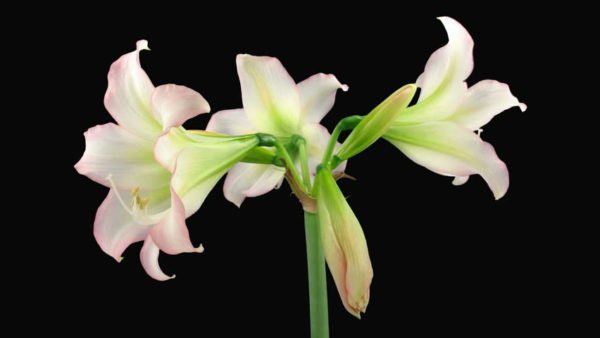

Flowering can be stimulated by stratification.
If eucharis does not bloom for a long time, you can use a little secret of experienced florists. The effect of low temperature stimulates the production of buds. It is necessary to move the flowerpot to a cool room. The temperature of the medium should not exceed + 15 degrees. Dry the substrate completely.
After 30 days, it is necessary to return the plant to its permanent growing area and create the hottest conditions possible. It is important to regularly monitor the condition of the lily. The plant should not form new leaves. It is not advisable to allow the discarding of old vegetative organs.
What to cut off a lily so that it doesn't smell
Pruning is practiced not only after flowering, but also during it. These flowers are well known for their pungent and strong aroma, which is produced by the release of special volatile oils from all organs of the plant. However, this smell is not always pleasant to humans, and in some cases it can cause allergic reactions.
What to do if the bouquet is beautiful and the smell is too heavy for you? In this case, it is recommended to remove the stamens of flowers, because it is on them that the smelling pollen is collected. To do this, you need to bring a paper bag to the bud and carefully cut the stamens into it. When doing this, use gloves to prevent pollen from getting on your fingers. This procedure should be repeated with each blooming flower.
The author of the video will tell you how to get rid of the smell of these flowers.
Planting in spring from seed
Planting lilies from seed in spring is the most productive and safest method of growing a plant.
The plant is not exposed to various pests and diseases that can lead to its death.
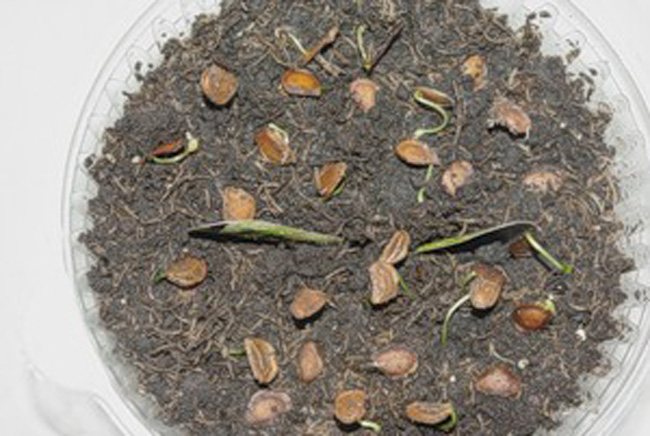

To properly plant seeds at home, you should follow a number of important recommendations:
- Ripe seeds are brown in color. They should be oval and slightly elongated in shape. They are 5 mm long and 1 mm wide.
- Once selected, the seeds can be used for sowing. But it is better to store them in a refrigerator at a temperature of 2-3 degrees.
- Planting should take place at the end of March.
- Before planting, it is required to prepare an earthen mixture. It can be bought ready-made in a special store. If you decide to do it yourself, then this requires mixing sod, leafy soil with coarse sand, everything is taken in equal quantities. Charcoal can be added additionally.
- What to do next? Seeds are best planted as seedlings. For this, boxes are prepared, a drainage layer is laid on their bottom and a mixture of soil is poured.
- Seeds are planted on the surface at a distance of 1-1.5 cm. They are covered with sand.
- Everything is carefully watered, covered with foil or glass.
- The boxes are removed in a dark place with a temperature of at least 20-25 degrees and left.
- After 20-25 days, sprouts will appear. During this period, it is recommended to place the boxes in a lighted place. Daylight hours should be at least 10-12 hours.
- Bulbs will appear from the seeds by autumn. At this time, they can be transplanted into pots.
Plant characteristic
Bulb
Lily Regale
It is in the bulb that the growth point and roots are located. They are round or egg-shaped. Consist of tiled scales. They are not closed and attached to the base located at the bottom of the bulb. They can be white, pinkish or yellowish. Bulb sizes range from 1 to 30 cm, depending on the type and variety.
The root system is of two types. The first type of root grows from the bottom of the bulb. The second type is airy, located above the bulb. Aerial roots die off when the leaves and peduncles dry up.
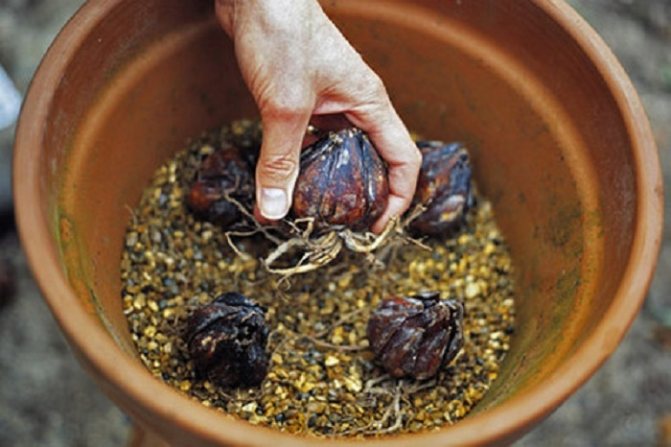

Home lily bulb
Stem
Domestic lily has a simple or low-branched, dense, straight stem that grows from the bulbous bottom. In indoor species, it is dark green and not very leafy.
Leaves
The leaves of the lily are mostly sessile, only in some species they are kept on petioles.
Their color is green. They look like plates that are located around the stem in a spiral or in a circle. Oval, lanceolate and linear leaves are distinguished in shape.
In the axil of the first lower leaf (from the bulb), a dark bud appears during the growing season, which gives rise to a new bulb.
Note! In a young bulb, fleshy scales fit tightly one after the other.
Flower
Appears on the flowering stem after the bulb has finally gained strength. Its length can reach 1 m. 4-5 buds appear on it.
There are three main flower shapes:
- bowl-shaped;
- funnel-shaped;
- with bent petals.
Flowers are arranged singly or are grouped into inflorescences.
Depending on the variety, the size of a lily flower growing in a pot can vary from 10 to 16 cm, although there are also larger specimens.
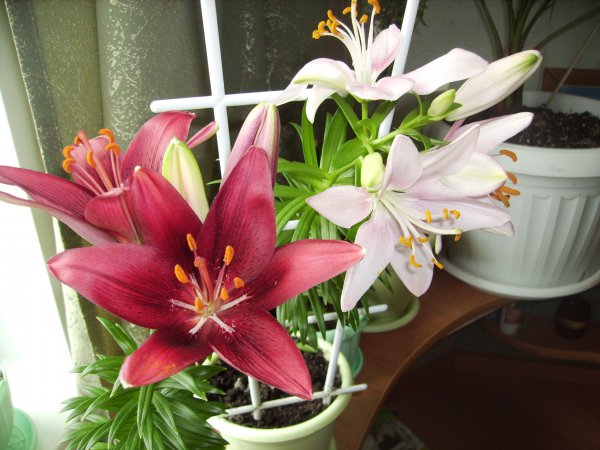

Lily flower
The perianth has six free lobes or petals with bent tops and scalloped or even edges.
Artificial pollination is necessary for the reproduction of lilies in the home.
Fetus
If the flower is not cut, but allowed to bloom, then a box will appear in its place, which is a fruit. Seeds of a triangular shape are located inside it. Each seed is covered with a papery or scaly skin.
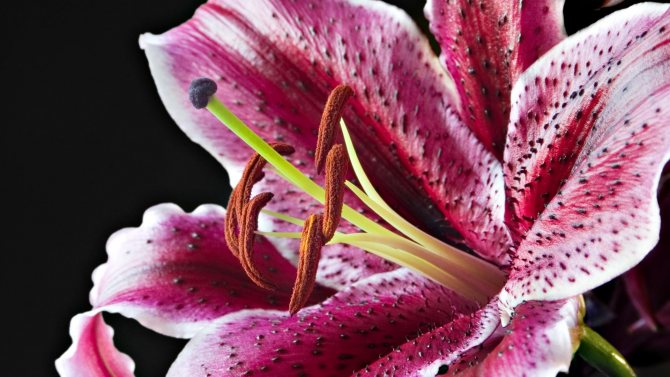

Fetus
Diseases and pests
The main reasons for the appearance of diseases in a beautiful plant are non-compliance with the above recommendations for care. It is quite simple to determine the presence of negative changes: with worms, the green mass begins to bend, you can guess about a spider mite by a thin, barely noticeable cobweb.
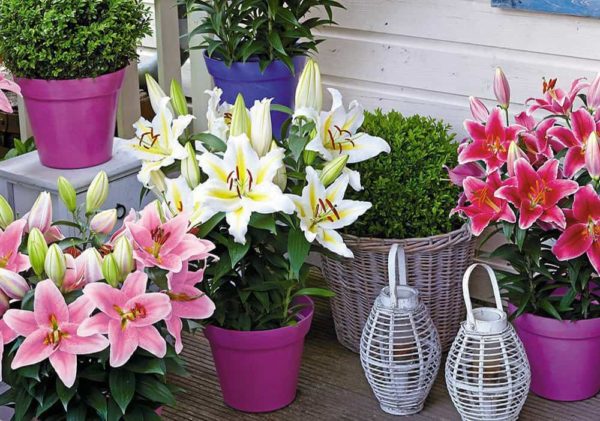

It is even easier to identify gray mold: brown leaves and a characteristic bloom, from which the plant disease was named. If a lily is struck by a mosaic, a modification of the usual type of inflorescences occurs. They acquire an uneven and faded color, become covered with spots or stripes. Unlike other diseases and pests, when damaged parts can be removed and treated with a store-bought compound, the mosaic plants are burned, and the pot and soil are thrown away.
